
hp
photosmart 720 series digital camera
user's manual

hp
photosmart 720 series digital camera
user's manual
Trademark and copyright information
?? Copyright 2002
All rights are reserved. No part of this document may be photocopied, reproduced, or translated to another language without the prior written consent of
The information contained in this document is subject to change without notice.
Microsoft?? and Windows?? are U.S. registered trademarks of Microsoft Corporation.
Apple, Macintosh, and Mac are registered trademarks of Apple Computer, Inc.

 SD Logo is a trademark.
SD Logo is a trademark.
Materials disposal
This HP product contains the following materials that might require special handling at
zMercury in the fluorescent lamp in the image LCD.
zAlkaline manganese
zLead in the solder and some component leads.
Table of Contents
Macintosh . . . . . . . . . . . . . . . . . . . . . . . . 19
Taking still pictures . . . . . . . . . . . . . . . . . . . . . . . . . 21 Using focus lock . . . . . . . . . . . . . . . . . . . . . . . 21 Using instant review . . . . . . . . . . . . . . . . . . . . . 22 Recording video clips . . . . . . . . . . . . . . . . . . . . . . . 22 Recording audio . . . . . . . . . . . . . . . . . . . . . . . . . . . 23 Using preview mode . . . . . . . . . . . . . . . . . . . . . . . . 23 Using the
5
Using hp instant share to print pictures . . . . . . . . . . .43 Using the hp instant share
Selecting images to be
Macintosh . . . . . . . . . . . . . . . . . . . . . . . . .46
Regulatory information . . . . . . . . . . . . . . . . . . . . . . 67
Appendix A: Batteries and accessories . . . . . .69
Purchasing accessories . . . . . . . . . . . . . . . . . . . . . . 71
Appendix B: Camera dock . . . . . . . . . . . . . . . . .73
Displaying images on a TV using the dock . . . . . . . . 76
Appendix C: Specifications . . . . . . . . . . . . . . . .77
7

1 Getting started
The HP Photosmart 720 digital camera is a 3.3
With HP Instant Share, you can select images to print or
You can enhance your experience by purchasing an
HP Photosmart 8881 Camera Dock. The Camera Dock allows you to easily download images to a computer, send images to a printer or television, recharge the camera batteries, and provide a convenient home for your camera.
NOTE A Dock Insert is included in your camera box. This Dock Insert enables your camera (and
others of the same model) to use the HP Camera Dock. Please do
not use it without the Camera
Dock and DO NOT discard it. Instructions for its use are included with the Camera Dock as well as in Appendix B of this manual.
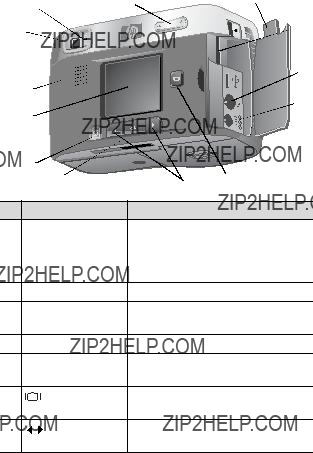
Camera Parts
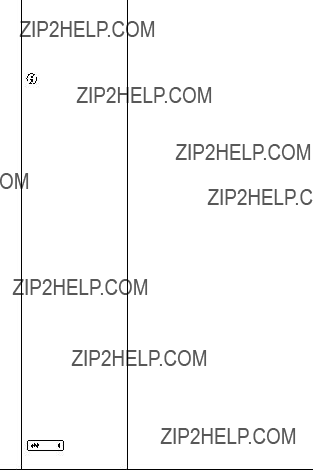
Blinking red - camera is either: starting up, charging the battery, sending/receiving USB, counting down
Out/In button
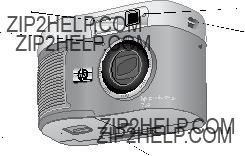
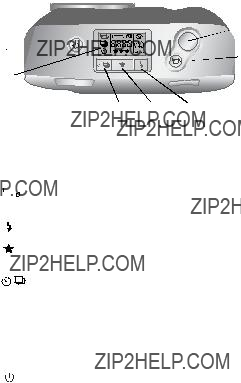
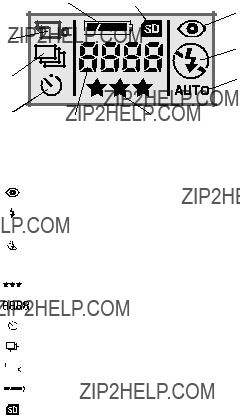

Setup
Attaching the wrist strap
Attach the wrist or neck strap as shown in the illustration.
NOTE It is easiest to install the strap by inserting it from the bottom of the strap mount first.
Installing the batteries
1 With the front of the camera facing you, slide the latch on the battery door to the right.
2 Holding on to the latch, pull the battery door toward you.
3Insert the batteries as indicated inside the door.
NOTE For more information about batteries, refer to
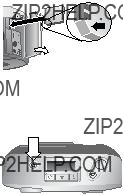
Inserting the memory card (optional)
Your digital camera contains 16 megabytes (MB) of internal memory so that you can store images and video clips in your camera. However, you can use an optional memory card (purchased separately) to expand the camera???s memory to store more images and video clips
NOTE Your camera supports up to a 128 MB memory card.
After unloading images to your computer, you can reuse the card.
1 With the camera off, open the
memory card door.
2 Insert the memory card as shown.
3 Close and fasten the memory card door.
To remove the card, pull it out of the camera.
Turning on power
Press the Power  button to turn on the camera. When the camera is ready, the viewfinder light stops blinking.
button to turn on the camera. When the camera is ready, the viewfinder light stops blinking.
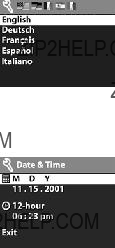
Choosing the language
The first time you turn the camera on, the following screen appears and prompts you to choose a language.
1Scroll to the language that you want by using the Arrow 
 buttons.
buttons.
2Press OK to select the highlighted language.
Setting the date and time
The camera has a clock that records the date and time at which you take each picture.
1Press the OK button repeatedly until your preferred date format appears, and then press the right
Arrow  button to highlight the date.
button to highlight the date.
2Press OK to select the first value,
and then use the 
 buttons to
buttons to
change it. Press OK to confirm. Set the remaining values in the same way. (M = Month, D = Day, Y = Year)
3Press the  button to highlight the time format, and then press OK if you want to change it.
button to highlight the time format, and then press OK if you want to change it.
4Press the  button to highlight the time. Set the time values in the same way you set the date values in step 2.
button to highlight the time. Set the time values in the same way you set the date values in step 2.
5When finished setting the date and time, press the  button to highlight Exit, and then press OK.
button to highlight Exit, and then press OK.
Installing the software
The camera software allows you to unload images from the camera, view them, print them, and
NOTE For Windows computers, the HP Photo & Imaging software needs at least Internet Explorer 5.0 (Service Pack 2) in order to function properly.
Windows
1Insert the HP Photo & Imaging CD into the CD drive of your computer. The installation window automatically appears.
NOTE If the installation window does not appear, click Start, and then click Run. Type X:\Setup.exe, where X is the letter of your CD drive.
2Click Next, and then follow the
To install any bonus software:
1Click Start, click Run, and in the Open box, type X:\Bonus\setup.exe (where X is the drive letter of your CD drive).
2Click OK, and then follow the
Macintosh
1Insert the HP Photo & Imaging CD into the CD drive of your computer.
2
3
To install any bonus software:
1
2
3Follow the

2 Taking pictures
Taking still pictures
You can take a picture almost any time the camera is on, regardless of what is being shown on the Image Display. To take a picture:
1 Frame the subject that you want
to photograph in the viewfinder.
2 Hold the camera steady, and 

 press the Shutter button. The
press the Shutter button. The 








 camera automatically adjusts
camera automatically adjusts 
 focus and exposure, and then takes the picture.
focus and exposure, and then takes the picture.
When you press down the Shutter button, you may notice that the viewfinder light is red, yellow, or green, and may or may not be blinking. See the description for Viewfinder light on page 11.
NOTE To achieve best focus in low light conditions, secure the camera to a tripod and make sure the focus area has sufficient contrast.
Using focus lock
Focus Lock allows you to focus on a subject that is not in the center of the image. It is also useful to verify that your image is in focus before taking the picture. To use Focus Lock:
1Press the Shutter button halfway down to lock the exposure and focus. When exposure and focus are locked, the green Viewfinder light comes on solid.
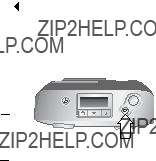
2When exposure and focus are locked, and you continue to hold the Shutter button halfway down, you can
3Press the Shutter button all the way down until you hear a click and see the image on the Image Display in Instant Review.
Using instant review
After you take a picture, the Image Display shows the image while it is being saved to memory. You can delete the image
Recording video clips
To record a video clip with audio for up to 30 seconds:
1 Frame the subject that you want to record.
2 Press and release the Video  button to start recording; REC appears on the Image Display.
button to start recording; REC appears on the Image Display.
3To stop recording, press the 
 button again. The camera automatically stops recording when the maximum clip length of 30 seconds is reached or memory is full.
button again. The camera automatically stops recording when the maximum clip length of 30 seconds is reached or memory is full.
After recording has stopped, the last frame of the video clip remains on the Image Display during Instant Review. During this time, the video clip is saved to memory unless you choose to delete it.
During video recording, the green viewfinder light and the red

Recording audio
After you take a still picture, you can add an audio annotation to it (for example to describe the location of the picture). For the details on how to do this, see Recording audio clips on
Using preview mode
You can use the Image Display as a viewfinder and show a more accurate view of what your picture will look like. This is useful for
1Press the Display 

 button to activate Preview mode.
button to activate Preview mode.
2Frame your subject in the Image Display, and then press the
Shutter button.
In the Preview screen, the current image quality setting (1, 2, or 3 stars) is shown in the
In addition to taking pictures and recording video, you can zoom in on your subject, adjust the flash setting, or increase the quality of your
NOTE Using the Image Display consumes a large amount of battery power.

Using the
The 

 button activates the
button activates the
Using the
1Secure the camera to a tripod or set it on a stable surface.
2Turn the camera on, and then frame your subject in the viewfinder.
3Press the 





 button until the
button until the  appears on the Status LCD.
appears on the Status LCD.
4Press the Shutter button all the way down, and then release it. The
Using burst
Burst is used to take multiple pictures in a row as quickly as the camera can. To use Burst:
1Press the 





 button until the Burst
button until the Burst 




 icon appears on the Status LCD.
icon appears on the Status LCD.
2Frame the subject and press the Shutter button all the way down and hold it.
3Flash is disabled and the camera takes pictures as quickly as possible until the memory is full or the Shutter button is released.

Using zoom
Optical zoom
Press the Zoom Out/Zoom In  button to move the lens between wide angle and telephoto positions (1 to 3x).
button to move the lens between wide angle and telephoto positions (1 to 3x).
You cannot adjust optical zoom while recording video clips.
Digital zoom
1Press the Display 

 button to turn on Preview mode, and then frame the picture using the Image Display.
button to turn on Preview mode, and then frame the picture using the Image Display.
2Use the Zoom in  button to optically zoom in to the maximum level, then release the button.
button to optically zoom in to the maximum level, then release the button.
3Press the  button again and hold it until you reach the desired
button again and hold it until you reach the desired
To turn digital zoom off, press the Zoom Out 
 button until zooming stops, or turn off the Image Display.
button until zooming stops, or turn off the Image Display.

Using the flash
When the camera is turned on, the flash is automatically set to Auto Flash. If you change the flash setting, the camera will remain in that setting until you change it again or turn off the camera.
To set the flash, press the Flash  button until the desired setting appears on the Status LCD. The following table describes the different flash settings:
button until the desired setting appears on the Status LCD. The following table describes the different flash settings:

Changing the image quality
The camera has three image quality settings: Good, Better, and Best. The current quality setting is displayed on the Status LCD.
To change the image quality setting, press the Quality  button until the desired setting appears on the Status LCD.
button until the desired setting appears on the Status LCD.
The following table identifies the approximate number of pictures that you can take at each setting based on internal memory or with a 16 MB memory card (purchased separately).

3Using playback and the main menu
Using playback to view images
After you have taken some pictures or video clips and they are stored in the camera, you can view them in Playback mode.
1Press the OK button to activate Playback mode. The most recently taken or viewed image appears on the Image Display. If the image is a video clip, it begins playing automatically within a few seconds.
2Scroll through the images by using the Arrow 
 buttons. Press and hold
buttons. Press and hold  or
or  to scroll automatically. If a video clip is playing, pressing the
to scroll automatically. If a video clip is playing, pressing the  button will reset the clip to the first frame of the video clip.
button will reset the clip to the first frame of the video clip.
In addition to seeing the images on the Image Display, some information about each image is also displayed above and below the image. The following table describes the information that may be viewed for each image.
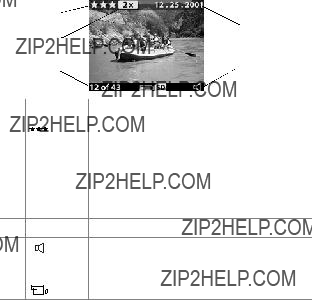
412.25.2001 Date the image was captured
5Visible if the current image has an audio
Visible if the current image is a video clip
NOTE To preserve battery life, you can connect to an optional HP AC adapter while viewing your images. For more information about accessories for your camera, see
Appendix A: Batteries and accessories on page 69.
If you do not have images stored in your camera or on the memory card, the No images screen appears on the Image Display.
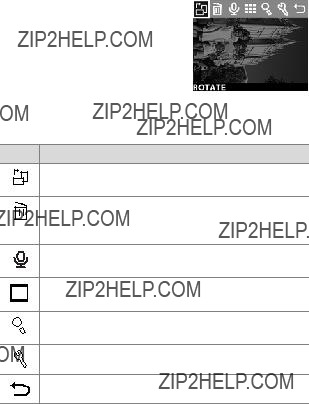
Using the main menu
Use the Main menu to view or modify images in the camera or to change the camera settings.
1To view the Main menu from Playback mode, press the OK button. If the Image Display is off, press the OK button twice.
2Scroll through the Main menu
options using the Arrow 
 buttons and select an option with the OK button.
buttons and select an option with the OK button.
The options available in the Main menu are:
Icon Description
Rotate - rotates the current image 90 degrees
clockwise
Delete - deletes the current image, all images, or
formats internal memory or the memory card. Also lets you undo the last deletion you made.
Record Audio - allows you to add an audio clip to still images
View Thumbnails - displays images in camera as thumbnails (nine per page)
Magnify - magnifies the current image on the Image Display by 3x or 6x
Setup - allows you to adjust the camera settings
Exit

Rotating images
NOTE This option works only on still images, not video clips.
1In Playback mode, scroll to the
image you want by using the 
 buttons, then press OK to display the Main menu.
buttons, then press OK to display the Main menu.
2In the Main menu, select the
Rotate 
 option. The current image is rotated 90 degrees
option. The current image is rotated 90 degrees
clockwise. While the image is being rotated, a progress bar appears below the image. If you press OK again while the progress bar is displayed, the image is rotated again.
Deleting images
1In Playback mode, scroll to the
image you want by using the 
 buttons, then press OK to display the Main menu.
buttons, then press OK to display the Main menu.
2In the Main menu, select the Delete  option.
option.
3In the Delete menu, highlight your selection, and then press OK.

Recording audio clips
NOTE This option works only on still images, not video clips.
1In Playback mode, scroll to the
image you want by using the 
 buttons, then press OK to display the Main menu.
buttons, then press OK to display the Main menu.
2In the Main menu, select the
Record Audio  option. Recording starts immediately, and
option. Recording starts immediately, and
the time remaining appears in the
3Press OK to stop recording. Within 4 seconds of stopping,
you can press the  button to cancel what was just recorded and
button to cancel what was just recorded and
Once an image has an audio clip attached to it, you can go back later and change it by selecting the image, then opening
the Record Audio  option again.
option again.

Viewing thumbnail images
1In Playback mode, press OK to display the Main menu.
2In the Main menu, select the View Thumbnails  option.
option.
3Scroll through the thumbnail
images by using the 
 buttons. The current image is highlighted with a yellow border. To move to the next set of images, use the
buttons. The current image is highlighted with a yellow border. To move to the next set of images, use the 
 buttons
buttons
4To view an enlarged image, select it, and then press OK.
Magnifying images
NOTE This option works only on still images, not video clips.
1In Playback mode, scroll to the image you want by using the 
 buttons, then press OK to display the Main menu.
buttons, then press OK to display the Main menu.
2In the Main menu, select the Magnify  option. This magnifies the image to three times its size (it does not permanently alter the image in the camera).
option. This magnifies the image to three times its size (it does not permanently alter the image in the camera).
3Scroll left or right in the image by
using the 
 buttons. To scroll up and down, press OK to display the Magnify menu, then press OK again to select the first icon in the
buttons. To scroll up and down, press OK to display the Magnify menu, then press OK again to select the first icon in the
menu. Use the 
 buttons to scroll up and down in the image.
buttons to scroll up and down in the image.
4To magnify the image to six times its size, select the Magnify
More  option. To return to Playback Mode, select the Exit
option. To return to Playback Mode, select the Exit  option.
option.

Using the setup menu
The Setup menu allows you to set a number of preferences on the camera, including:
zselecting up to three different exposure settings (exposure compensation, white balance, and ISO) to use when taking pictures
zsetting date and time
zselecting the image to be used for the welcome screen when the camera is turned on
zsetting the USB configuration (how the camera appears when connected to a computer)
zmoving images from internal memory to a memory card
zselecting the language the camera interface will use
1In Playback mode, press OK to display the Main menu. If the Image Display is off, press OK twice to get to the Main menu.
2In the Main menu, select the Setup  option.
option.

Exposure settings
Use these settings to override the camera???s automatic exposure settings. When you change these settings manually, the current settings appear at the top of the Image Display in Preview mode (except when you are using Digital Zoom).
1In the Setup menu, select
Exposure Settings.
2In the Exposure Settings menu,
use the 
 buttons to scroll to
buttons to scroll to
Exposure Compensation  ,
,
White Balance  , or ISO
, or ISO  , and press OK.
, and press OK.
Exposure compensation
This setting (  ) alters the exposure to compensate for lighting conditions. Settings range from
) alters the exposure to compensate for lighting conditions. Settings range from
then examine the image in Playback mode. If the image is too dark, increase the compensation. If the image is too bright, decrease the compensation.
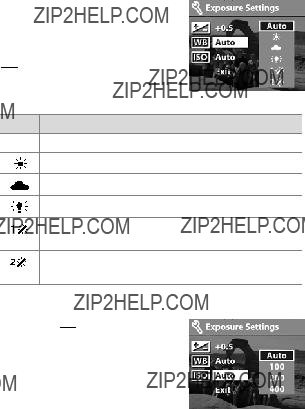
White balance
In some cases, it may be necessary to
(  ) according to the following situations.
) according to the following situations.
Icon Description
Auto Auto - this is the default setting
Daylight - recording outdoors on a bright day
Cloudy - recording under overcast or twilight skies
Tungsten - recording under incandescent lighting
Fluorescent 1- recording under cool or daylight fluorescent lighting
Fluorescent 2 - recording under warm fluorescent lighting
ISO
This setting (  ) adjusts how quickly the camera reacts to light. Higher ISO numbers allow higher shutter speeds. Switch to higher speeds while taking pictures in dark areas or fast moving objects.
) adjusts how quickly the camera reacts to light. Higher ISO numbers allow higher shutter speeds. Switch to higher speeds while taking pictures in dark areas or fast moving objects.
NOTE Higher ISO numbers can
decrease image quality, so use as low an ISO speed as possible.

Date & time
This setting determines the current date and time for the camera. This is usually done when you first set up the camera, but you may need to
1In the Setup menu, select Date & Time.
2Follow the same procedure used in Setting the date and time on page 17.
Welcome screen
This setting determines the image that appears when the camera is turned on. You can select any image available in the camera or the HP logo, which is the default setting.
1In Playback mode, scroll to the image you want by using the 
 buttons, then press OK to display the Main menu.
buttons, then press OK to display the Main menu.
2In the Main menu, select the Setup  option.
option.
3In the Setup menu, select Welcome Screen.
4Select This Image to use the current image, HP Logo to return to the factory setting, or Exit to leave the current welcome screen unchanged.
5Press OK to activate the selection you made in the previous step.

USB configuration setting
This option determines how the camera appears when connected to a computer.
1In the Setup menu, select the
USB Configuration option.
2In the USB Configuration menu,
use the Arrow 
 buttons to
buttons to
make one of the following choices and press OK.
???Digital Camera - causes the computer to recognize the camera as a digital camera (Picture Transfer Protocol (PTP) standard). This is the default setting on the camera.
???Disk Drive - causes the computer to recognize the camera as a disk drive (Mass Storage Device Class (MSDC) standard). Use this setting for unloading and sharing on a Macintosh computer or on Windows system that does not have the HP Photo & Imaging software installed on it.

Move images to card
This option lets you move images from the camera???s internal memory to a memory card. It appears only if a memory card is installed and internal memory contains at least one image.
1In the Setup menu, select the option Move Images to Card.
2If the memory card can store all of the images from internal memory, you are prompted to move all images. If the memory card is running out of space, you can
move only the number of images that will fit on the card. If you select Yes to move images, they are moved to the card, and all moved images are deleted from internal memory.
NOTE When a memory card is inserted, only the images on the card can be viewed on the Image Display. To view the images stored in internal memory, remove the memory card.
Language
This setting determines the language of the menus and the text on the Image Display.
1In the Setup menu, select the Language option.
2Follow the same procedure used in Choosing the language on page 17.

4 Usingshare hp instant
This camera has an exciting feature called HP Instant Share. This feature lets you select images in the camera to be automatically processed later when the camera is connected to your computer or to certain HP printers.
For example, you can select images that you want to have printed, then connect the camera to the computer or printer, and the selected images will be printed automatically.
As another example, you can select images in the camera to be automatically processed by HP???s
When you press the Share  button on the camera, the most recently taken or viewed image appears on the Image Display, along with any
button on the camera, the most recently taken or viewed image appears on the Image Display, along with any 
 buttons allow you to scroll through the images to see destinations for the other images in the camera.
buttons allow you to scroll through the images to see destinations for the other images in the camera.

After you press the Share  button, you can activate the Share menu by pressing OK. The following illustration and table provide information about the Share menu.
button, you can activate the Share menu by pressing OK. The following illustration and table provide information about the Share menu.
1 2 3 4
Using hp instant share to print pictures
1Turn on the camera, then press the Share  button.
button.
2Use the 
 buttons to scroll to the image you want to print. Video clips cannot be selected for printing.
buttons to scroll to the image you want to print. Video clips cannot be selected for printing.
3Press OK to activate the Share menu, then use the 
 buttons to scroll to the print option you want.
buttons to scroll to the print option you want.
4Press OK, and a  appears next to that option.
appears next to that option.
5Scroll to other images by using the 
 buttons and repeat steps 3 and 4 to select print options for each image.
buttons and repeat steps 3 and 4 to select print options for each image.
6When you are finished selecting all the images you want to have printed, press the Share  button.
button.
7The next time you connect the camera to your computer or a compatible printer, the images you selected will be automatically printed. See Chapter 5: Unloading, printing, & displaying images on page 47 for information about connecting the camera to a computer or printer.
NOTE The Share menu creates a standard Digital Print Order Format (DPOF) file for print options.
Using the hp instant share
Using HP Instant Share to
1Adding
2Selecting images to be
3Connecting the camera to your computer to send selected images.
Adding, modifying, and removing
NOTE You will need an internet connection to complete this procedure.
1Turn on the camera, press the Share  button, then select the
button, then select the 

 option and press OK. A message on the camera Display appears asking you to connect the camera to your computer.
option and press OK. A message on the camera Display appears asking you to connect the camera to your computer.
2Connect the camera to your computer (by using the USB cable or an optional HP Camera Dock)
3On the computer, click on Retrieve from Camera.
4In the screen called Modify Share Menu check to see that Photo
5If you are using a Macintosh computer, skip to step 7. If you are using a computer running Windows, you will be asked to sign in to HP???s Passport program. HP Passport allows you to use HP???s free
6Once you have successfully registered, sign in to the HP Passport program, and then the Photo
7Your newly added
8When you have finished adding
camera from the computer, and press the Share  button to view the new
button to view the new
9You are now ready to select images on the camera to be
Selecting images to be
1Turn on the camera, then press the Share  button.
button.
2Use the 
 buttons to scroll to an image you want to
buttons to scroll to an image you want to
3Press OK to activate the Share menu, then use the 
 buttons to scroll to the
buttons to scroll to the
4Press OK to select the
5Scroll to other images by using the 
 buttons and repeat steps 3 and 4 to select
buttons and repeat steps 3 and 4 to select
6When you are finished selecting all the images you want to  button.
button.
7The next time you connect the camera to your computer, images are unloaded to the computer, and the images selected for
The way images are
Windows
Images are not
Macintosh
Images are
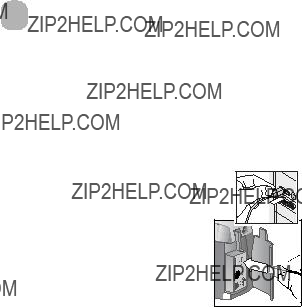
5Unloading, printing, & displaying images
Once you have taken pictures, you can unload them from your camera to a computer, print them directly to a printer, or display them on a television.
Unloading to a computer
NOTE You can also use the optional HP
Camera Dock to do this task. See
Appendix B: Camera dock on page 73.
NOTE If you are using a Macintosh computer, switch the camera to Disk Drive in the USB Configuration menu found in the Setup menu.
1Your camera came with a special USB cable for connecting the camera
to a computer. Connect the larger end of that USB cable to the computer.
2Open the memory card door on the side of the camera and connect the small end of the USB cable to the USB connector on the camera.
3Turn on the camera. The HP Image Unload software will launch on your computer, and the images in the camera will automatically unload to the computer. If there were any images in the camera that were selected in the Share menu for printing or

4When the unload screen on the computer says Finished, your images have been saved and shared. You can now disconnect the camera from the computer.
NOTE To unload the camera images to a computer that does not have the HP Photo & Imaging software installed on it, switch the camera to Disk Drive in the USB Configuration menu found in the Setup menu. This allows the camera to appear as another disk drive on the computer.
Printing images
NOTE You can also use the optional HP Camera Dock to do this task. See Appendix B: Camera dock on page 73.
To print images that have been unloaded to the computer, you can use the HP Photo & Imaging software that was shipped with the camera.
You can also connect the camera directly to any HP DeskJet or Photosmart printer that has a USB connection, then print images selected from the camera Share menu or all images in the camera.
1 Your camera came with a special USB cable for connecting the camera directly to a printer.
2 Connect the square end of the USB
cable to the printer.
3 Open the memory card door on the side of the camera and connect the small end of the USB cable to the USB connector on the camera.
4Adjust the settings in the Print Setup
menu on the camera to complete the printing process.
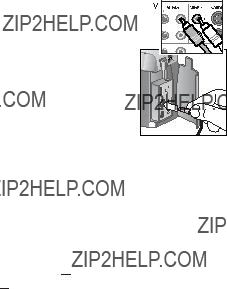
Displaying images on a TV
Images in your camera can easily be displayed as a slideshow on almost any television (TV).
NOTE You can also use the optional HP Camera Dock to do this task. See Appendix B: Camera dock on page 73.
1 To connect the camera directly to a TV, you must first purchase an A/V (Audio/Video) cable. For details, see
Purchasing accessories on page 71.
2 Connect the A/V cable to the TV connector on your camera and then to the A/V inputs on the TV.
3 Refer to the documentation for the TV to determine how to set the TV to take input from your camera instead of the antenna or cable TV.
Displaying a slideshow
Once the camera is connected to the TV with the A/V cable or the optional HP Camera Dock, you are ready to start.
1Turn on the camera. If you are using an A/V cable, the Slideshow menu will appear on the camera. If you are using
the HP Camera Dock, the 

 button on the dock should light up. Press the
button on the dock should light up. Press the 

 button, and the Slideshow menu will appear on the camera. The options in the Slideshow menu are described in the following table
button, and the Slideshow menu will appear on the camera. The options in the Slideshow menu are described in the following table

.
2To change an option, highlight it and press OK. Each time OK is pressed, the next option is selected. All selections except Begin are stored in the camera and become the defaults until changed.
3To start the slideshow, select Begin. The camera???s Image Display turns off and the slideshow starts on the TV. The slideshow begins with the image last taken or viewed and displays each image in sequence. When the end is reached the sequence moves to the beginning and continues. Audio and video clips are always played to completion, regardless of the rate you specified in the Slideshow menu.
4To exit the slideshow, unplug the A/V cable or press the 

 button on the dock.
button on the dock.
At any time during the slideshow, you can press the 
 buttons to move forward or backward. Pressing and holding these keys auto repeats similar to Playback mode.
buttons to move forward or backward. Pressing and holding these keys auto repeats similar to Playback mode.
NOTE The Main menu and Share menu are available during the slideshow. You can rotate, delete, view thumbnails, magnify, share, etc. during the slideshow.

6 Troubleshootingsupport and
Problems and solutions

Problem
The wrong date and/or time is shown.
I replace the camera batteries frequently.
Error messages
You may receive error messages on the camera???s Image Display, or on your computer screen.
Error messages on the camera
Error messages on the computer
Getting assistance
Finding help on the web
HP product support
Visit www.hp.com/cposupport/loc/regional.html, select your language, and then type your camera model in the ???quick find??? box to find information about setting up and using your camera, downloading drivers, solving a problem, ordering, and warranty information.
HP photosmart website
Visit www.hp.com/photosmart for tips on using your camera more effectively and creatively as well as HP digital camera driver updates and software.
HP accessibility website
Visit www.hp.com/hpinfo/community/accessibility/prodserv if you have a disability and need help.
Contacting hp customer support
In addition to the Web, you can contact HP by telephone or mail for support and service for your camera. Prices, availability, and hours of support are subject to change without notice.
How hp can help
The HP support hotline can help resolve problems with setup, installation, configuration, and operation. For help with
Before you call
Review troubleshooting tips.
Have the following information ready before you call:
zserial number (found on the bottom of your camera)
zproduct name
zdate of purchase
Service is free of charge during the warranty period. Beyond the warranty period, a service fee will be charged.
Obtaining support in the United States
Free telephone support for one year
Within one year of your purchase, telephone support is provided to you free of charge. If this is a long distance call for you, long distance charges will apply.
Call (1) (208)
Our support staff is available from 6 am to 10 pm Mountain Time, Monday through Friday, or 9 am to 4 pm Saturday.
If you think your HP product might need service, call HP Customer Support, which can help determine if service is required. Or, visit www.hp.com/cpsosupport/guide/psd/ repairhelp.html for the nearest sales and service office.
After the first year
Call (1) (208)
A fee of $25.00 per call (U.S.) will be charged to your credit card. Charges begin only when you connect with a support technician.
Upgraded warranty options
You can select one of the following upgraded warranty options (available in the U.S. only):
zStandard Next Day Exchange
zAccidental Damage Protection with Next Day Exchange
Upgrade your standard factory warranty to three years with the HP SupportPack. Service coverage begins on product purchase date and the pack must be purchased within the first 180 days of product purchase. HP will determine the hardware service offering based upon the outcome of system
For more information call
Obtaining support worldwide
Telephone support is free for one year in Asia and the South Pacific, and for 30 days in the Middle East and Africa.
The information contained in this document and the applicable conditions for HP phone support are subject to change without notice. Please check for the latest information and conditions at www.hp.com/cposupport/loc/regional.html.
Alternatively, you can ask your dealer or call HP at the phone number listed in this document. For English support in Europe, contact +44 (0) 207 512 52 02.
Algeria +213 (0)
Australia +63 (3) 8877 8000 (or local (03) 8877 8000) Austria +43 (0)
Bahrain
Belgium Dutch: +32 (0)2 626 8806 French: +32 (0)2 626 8807
Brazil (11)
Canada
Chile 800 360 999
Colombia
Czech Republic +42 (0)2 6130 7310 Denmark +45 39 29 4099
Egypt 02 532 5222
Finland +358 (0)203 47 288
France +33 (0)8 92 69 60 22 (Euro 0.34/minute) Germany +49 (0)180 52 58 143 (Euro 0.12/minute) Greece +30
Guatemala 1 800 999 5305
Hong Kong SAR +852 3002 8555 Hungary +36 (0)1 382 1111
India 1 600 112267 or +91 11 682 6035 Indonesia +62 (21) 350 3408
Ireland +353 (0)1 662 5525
Israel +972 (0)
Japan
Korea, Republic of +82 (2) 3270 0700 (Seoul)
Malaysia
Mexico 52 58 9922 (Mexico City)
Middle East/Africa +44 (0) 207 512 52 02
Morocco +212
Netherlands +31 (0)20 606 8751
New Zealand +64 (9) 356 6640
Norway +47 22 11 6299
Peru 0 800 10111
Philippines +63 (2)
Poland +48 22 865 98 00
Portugal +351 21 3176333
Puerto Rico 1 877 232 0589
Romania +40 1 315 44 42 (or local 01 3154442)
Russian Federation +7 095 797 3520 (Moscow)
+7 812 346 7997 (St. Petersburg)
Saudi Arabia 800 897 14440
Singapore +65
Slovakia
South Africa 086 000 1030 (RSA)
Spain +34 902 321 123
Sweden +46 (0)8 619 2170
Switzerland +41 (0)848 80 11 11
Taiwan 0 800 01 0055
Thailand +66 (2) 661 4000
Tunisia +216
Turkey +90 216 579 71 71
Ukraine +7
United Arab Emirates 971 4 883 8454
United Kingdom (UK) +44 (0) 207 512 52 02 Venezuela 0 800 4746 8368
Viet Nam +84 (0) 8 823 4530
The HP photosmart 720 camera comes with a one year limited warranty.
zHP warrants to you, the
zHP warrants to you that HP software will not fail to execute its programming instructions after the date of purchase, for the period specified above, due to defects in material and workmanship when properly installed and used. If HP receives notice of such defects during the warranty period, HP will replace software which does not execute its programming instructions due to such defects.
zHP does not warrant that the operation of HP products will be uninterrupted or error free. If HP is unable, within a reasonable time, to repair or replace any product to a condition as warranted, you will be entitled to a refund of the purchase price upon prompt return of the product.
zHP products may contain remanufactured parts equivalent to new in performance or may have been subject to incidental use.
zWarranty does not apply to defects resulting from (a) improper or inadequate maintenance or calibration, (b) software, interfacing, parts or supplies not supplied by HP, (c) unauthorized modification or misuse, (d) operation outside of the published environmental specifications for the product, or (e) improper site preparation or maintenance.
zTO THE EXTENT ALLOWED BY LOCAL LAW, THE ABOVE
WARRANTIES ARE EXCLUSIVE AND NO OTHER WARRANTY OR
CONDITION, WHETHER WRITTEN OR ORAL, IS EXPRESSED OR
IMPLIED AND HP SPECIFICALLY DISCLAIMS ANY IMPLIED
WARRANTIES OR CONDITIONS OF MERCHANTABILITY,
SATISFACTORY QUALITY, AND FITNESS FOR A PARTICULAR
PURPOSE. Some countries, states or provinces do not allow limitations on the duration of an implied warranty, so the above limitation or exclusion might not apply to you. This warranty gives you specific legal rights and you might also have other rights that vary from country to country, state to state, or province to province.
zHP???s limited warranty is valid in any country or locality where HP has a support presence for this product and where HP has marketed this product. The level of warranty service you receive may vary according to local standards. HP will not alter form, fit or function of the product to make it operate in a country for which it was never intended to function for legal or regulatory reasons.
zTO THE EXTENT ALLOWED BY LOCAL LAW, THE REMEDIES IN
THIS WARRANTY STATEMENT ARE YOUR SOLE AND EXCLUSIVE
REMEDIES. EXCEPT AS INDICATED ABOVE, IN NO EVENT WILL
HP OR ITS SUPPLIERS BE LIABLE FOR LOSS OF DATA OR FOR
DIRECT, SPECIAL, INCIDENTAL, CONSEQUENTIAL (INCLUDING
LOST PROFIT OR DATA), OR OTHER DAMAGE, WHETHER BASED IN CONTRACT, TORT, OR OTHERWISE. Some countries, states or provinces do not allow the exclusion or limitation of incidental or consequential damages, so the above limitation or exclusion may not apply to you.
zTHE WARRANTY TERMS CONTAINED IN THIS STATEMENT,
EXCEPT TO THE EXTENT LAWFULLY PERMITTED, DO NOT
EXCLUDE, RESTRICT OR MODIFY AND ARE IN ADDITION TO THE
MANDATORY STATUTORY RIGHTS APPLICABLE TO THE SALE OF
THIS PRODUCT TO YOU.
Regulatory information
For regulatory information, see the regulatory_supplement.htm file on the software CD that came with your camera.

Appendix A: Batteries and accessories
Managing batteries
When the batteries are removed from the camera, the date and time settings are preserved for approximately 10 minutes. If the camera is without batteries for longer than 10 minutes, the clock is set to the last time and date at which the camera was used. You may be prompted to update the date and time.
The following battery levels are displayed on the Status LCD and the Image Display.
The camera uses four AA batteries. Acceptable batteries include
NOTE If you do not intend to use your camera for extended periods of time (more than a month), we strongly recommend that you remove the batteries from the camera.
Extending battery life
zUse an optional HP AC adapter or HP Camera Dock when unloading pictures to your computer, printing, or connecting to the TV.
zUse the optical viewfinder to frame pictures instead of the Image Display. Leave the Image Display off when the camera is on.
zTurn the camera off during a pause in picture taking.
zUse the Auto Flash setting rather than Flash On or
Rechargeable batteries
Nickel Metal Hydride (NiMH) batteries can be recharged by using a battery charger, the HP Camera Dock, or in the camera when it is connected to the AC adapter. Some things to keep in mind when using NiMH batteries are:
zAlways recharge all four NiMH batteries at the same time. One
zFor NiMH batteries to reach optimal capacity and performance, they should first be discharged completely and recharged four separate times.
zAfter

Power conservation
To conserve battery power, the Image Display turns off automatically if there is no button activity for 60 seconds. If no buttons are pressed for 10 minutes, the camera turns off (unless it is printing or connected to a computer or TV).
Purchasing accessories
You can purchase additional accessories for your camera from your local retailer or online at www.hpshopping.com. Some accessories for the HP photosmart 720 digital camera are listed below:
zHP AC power adapter (HP Supports only HP AC adapters and other accessories expressly approved by HP)
???North
???Outside of North
zHP Photosmart 8881 Camera Dock
zSecure digital (SD) memory card only (128 MB is the maximum usable card size)
zHP audio/video accessory cable
RCA plugs on one end and a 1/8 inch (3.175 mm)
zHP Digital Camera Accessory Kit (Y1788 for United States, Y1789 for outside the United States). Contents include:
???Camera bag
???Rechargeable NiMH batteries
???Battery charger
zHP Digital Camera Accessory Kit (C8884A). Contents include:
???Camera bag
???Rechargeable NiMH batteries
???Battery charger
???32 MB SD memory card
???Tripod
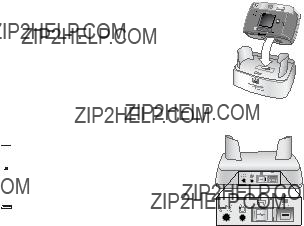
Appendix B: Camera dock
NOTE The HP Camera Dock does not work without AC power. Be sure to use ONLY the HP AC adapter and the cables that came with the Camera Dock.
1Follow the setup instructions provided with the Camera Dock. This includes installing the Dock Insert onto the dock, installing rechargeable batteries in the camera, connecting the AC power source, and connecting the Camera Dock to a computer, printer, and/or television.
2 Make sure your camera is set up correctly and remove any cables that may be attached to it before putting
it in the dock.
3 Place the camera in the Camera Dock with the rear of the camera facing the front of the Camera Dock.
The Camera Dock has three I/O connectors on the back:



 ???Connects
???Connects

There is a sliding door over the computer and printer connectors that
prevents you from using both connectors at the same time (the Camera Dock is not a USB hub).

The Camera Dock has a light near the top front that provides battery charging status. A blinking light indicates that batteries are charging.
There are two buttons on the front that light up, showing the camera is connected to the associated device.

 ???This
???This
connection to the computer or the printer, depending on which of those devices is connected to the dock.



The functions of the dock button lights are described below:
Unloading images to a computer using the dock
NOTE If you are using a Macintosh computer, switch the camera to Disk Drive in the USB Configuration menu found in the Setup menu.
1Check that the HP Camera Dock is connected to your computer.
2Place the camera in the Camera Dock. It will turn on automatically, and a dock intro screen will appear.
3Press the 
 button on the dock to start the unload process. The HP Image Unload software will launch on your computer, and the images in the camera will automatically unload to the computer. If there were any images on the camera that had been selected in the Share menu for printing or
button on the dock to start the unload process. The HP Image Unload software will launch on your computer, and the images in the camera will automatically unload to the computer. If there were any images on the camera that had been selected in the Share menu for printing or
4The camera will return to the dock intro screen when your images have been saved and shared. You can now take the camera out of the dock, or leave it there to recharge the camera batteries.

Printing images using the dock
1Check that the HP Camera Dock is connected to your printer. (The dock cannot be connected directly to both a computer and a printer at the same time).
2Place the camera in the Camera Dock. It will turn on automatically, and a dock intro screen will appear.
3Press the 
 button on the dock to start printing.
button on the dock to start printing.
4Adjust the settings in the Print Setup menu on the camera to complete the printing process.
5The camera will return to the dock intro screen when printing is complete. You can now take the camera out of the dock, or leave it there to recharge the camera batteries.
Displaying images on a TV using the dock
1Check that the HP Camera Dock is connected to your TV.
2Refer to the documentation for your TV to determine how to set the TV to take video input from your camera instead of the antenna or cable TV.
3Place the camera in the dock. It will turn on automatically, and a dock intro screen will appear.
4Press the 

 button on the dock, and the Slideshow menu will appear on the camera???s Image Display.
button on the dock, and the Slideshow menu will appear on the camera???s Image Display.
The rest of this procedure is described in the section Displaying a slideshow on page 49.

Appendix C:
Specifications
Index
A
AA batteries 69 AC power adapter
HP part number 71, 79 accessories for camera 71 alkaline batteries 69 arrow buttons 10
audio clips, record 12 audio clips,record 23, 33 audio/video
Auto Flash setting 26 status icon 14
B batteries
condition icons 69 condition status icon 14 door on camera 12 extend life 70
install 15 rechargeable 70 types to use 69 view levels of life 69
Best quality setting description 27 resolution 77
Better quality setting description 27 resolution 77
blinking lights
Index
bonus software 18, 19 burst
take pictures with 24 buttons
C
Camera Dock. See HP Camera Dock
compression format 79 computer
connect camera to 47 connect dock to 73
connections
as a USB Mass Storage Device Class (MSDC) 39
to Camera Dock 73 to computer 47
connectors audio/video 10, 49
HP Camera Dock 12, 73 power adapter 10
81
D
date and time change 38 set 17
delete
images during Instant Review 22
video clips during Instant Review 22
Digital Print Order Format 43 digital zoom 25
disk drive, connect as 39 Display button 10
dock. See HP Camera Dock DPOF 43
E
addresses, customizing the Share menu 44
images using HP Instant Share 41
empty batteries, icon 69 enlarge view of images 34 error messages
exposure compensation, setting 36
F files
compression formats 77 delete on memory card 32 DPOF 43
82
flash button 13 light 12 range 78 settings 26
Flash Off setting 26 status icon 14
Flash On setting 26 status icon 14
focus lock 21 range 78
format memory 32 full batteries, icon 69
G
Good quality setting description 27 resolution 77
H
help from customer support 60 HP Camera Dock
HP Instant Share button 11 description 9, 41 turn on/off 11
Index
I
Image Display 11 image quality
images delete 32
magnify view in camera 34 move from internal memory to
quality settings 27, 77 remaining in camera 14, 23 rotate 32
thumbnails 34 unloading camera to
unloading using Camera Dock 75
view 29 install
bonus software 18, 19 Camera Dock 9 memory card 16 software 18
Instant Share. See HP Instant Share
internal memory, move images to memory card 40
L language
choose at startup 17 LEDs (lights) on camera
Index
lights
on camera, blinking 11, 21 on dock, blinking 74
M
Macintosh computer bonus software 19 connect to 47, 75 install software 19
USB setting on camera 39 magnify view of images 34 Main menu 31
on/off button 11 memory card
capacity 77 delete files 32 door 10 install 16
status icon 14 menu, Main 31 messages
microphone 12 mount for tripod 12
N
NiMH batteries 69 NTSC video format 50
number of images remaining 23 number of images remaining,
83
O
OK button 11 optical viewfinder 11 optical zoom 25
P
PAL video format 50
share 41 take 21 thumbnails 34
play video clips 29 Playback mode 29 power
battery level icons 69 button 13 specifications 79 turn on/off 16
Preview mode 23 print images
directly from camera 48 from computer 48 using Camera Dock 76
using HP Instant Share 41 printer
connect dock to 73 connect to camera 48
problems troubleshooting 51
Q
84
quality levels description 27, 77
R range
rechargeable batteries 70 record
audio clips 23, 33 video clips 22
record audio clips 12 recycling information 3
review pictures 22 rotate images 32
S
SD card status icon 14
button 13 light 12 status icon 14
take pictures with 24 Setup menu 35
Share button 11 Share menu
customize 44 description 42
share pictures 41 shutter button
Index
slideshow
software
speaker 11 specifications 77 status LCD
T
thumbnail images, view 34 time and date
tripod mount 12 troubleshoot problems 51 turn on/off
camera power 13, 16 HP Instant Share 11 Main menu 11 Preview mode 10, 23
TV
U
unloading images camera to computer 47 using Camera Dock 75
USB
change configuration 39 connector, camera 10 connector, Camera Dock 73
V video
recording status icon 14 video clips
view
viewfinder light, description 11
warranty upgrade options 62 Web sites for HP 60
welcome screen, customize 38 white balance, setting 37 Windows computer
bonus software 18 install software 18
wrist strap

www.hp.com/photosmart
Printed in Singapore 2002